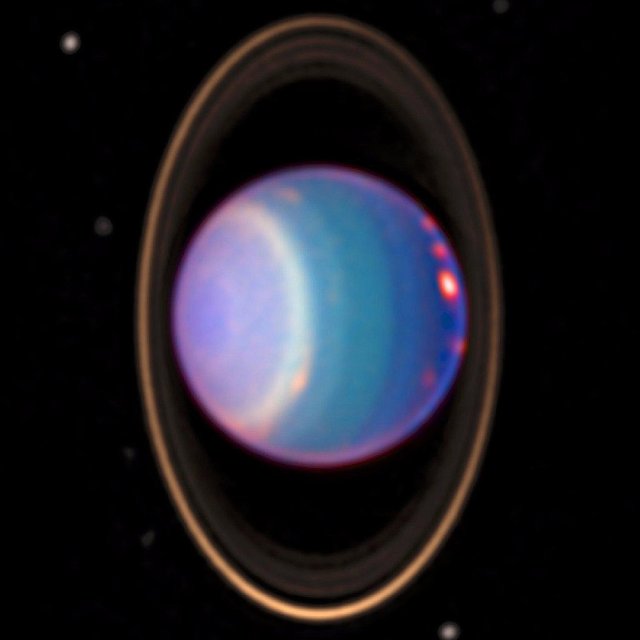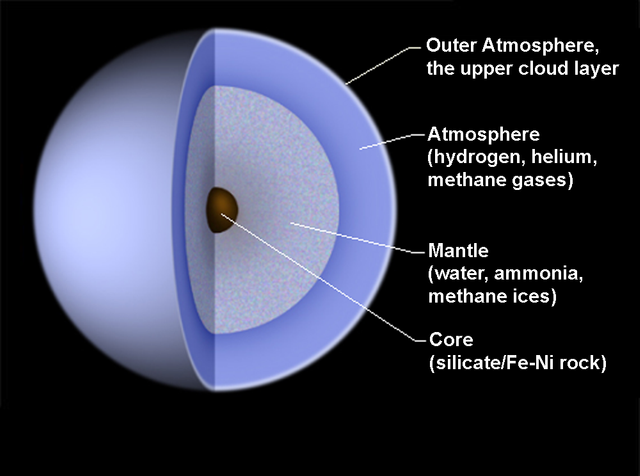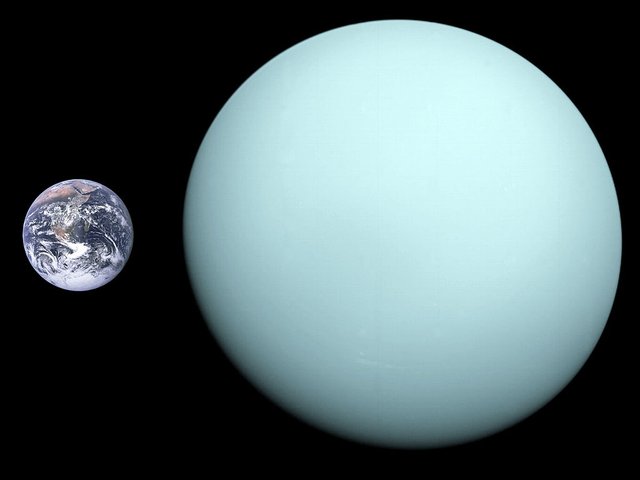Uranus - mysterious giant
I will describe for you this time the 7th planet of our Solar System. Uranus is a mysterious blue-green world that has only recently revealed its secrets to us. It is the third largest gas giant, about four times the diameter of Earth.

By NASA/JPL-Caltech link [Public domain]
Uranus was discovered in 1781 and is the first planet discovered using a telescope. It is hardly visible to the naked eye (it looks like a star with low brightness). This planet wasn't discovered by the ancient observers just because of the low brightness and slow motion in the sky. Is really far to planet Uranus. It circulates 2.9 billion km from the Sun. It's two times farther away than Saturn and four times farther away than Jupiter! That's why until recently we didn't know much about him. We owe most of the information to the only Voyager 2 probe that passed the planet in 1986. This mysterious world certainly contains many secrets that are worth discovering!

By Hubble Space Telescope - NASA Marshall Space Flight Center link [Public domain]
Uranus is called the ''planet on the side''. The axis of rotation lies almost exactly in the plane of its orbit. So we can say that the planet is actually rolling around the Sun. This results in extraordinary consequences. During the 84 year cycle around the Sun, each of the Uranus poles remains 42 years in total darkness to then bathe in the sunshine for the next 42 years! You would expect higher temperatures in the illuminated pole. It isn't so, and this is because the planet is far away from the Sun and the atmosphere of the planet well insulates sun rays falling on it. The atmosphere of Uranus is the coldest planetary atmosphere in the Solar System. The temperature recorded here was -224 degrees Celsius! The system of narrow Uran rings was discovered in 1977 from Earth. The Voyager 2 spacecraft confirmed this. However, they aren't as spectacularly visible as the rings of Saturn.

By WolfmanSF link [Public domain]
Under the clouds, Uranus, like other gaseous giants, probably has a small rocky core, but there is no metallic hydrogen like in the case of Jupiter and Saturn. The nucleus is surrounded by molecular hydrogen. Uranium doesn't have a well-defined solid surface. The ocean of hydrogen goes into dense gas layers. The outer layers of the planet contain hydrogen and helium. In the highest parts of the atmosphere of Uranus it is so cold that methane and ammonia turn into ice crystals. The blue-green color of the planet is mainly due to the presence of methane. Because of the enormous distance that separates us from this world, we will have to wait many years for a closer examination of the atmosphere of this planet.

By NASA link [Public domain]
At the end, compare the size of Uranus and our Earth. It's smaller than Jupiter and Saturn, but still a giant. Before the visit of the Voyager probe, we knew only 5 moons of Uranus. The probe showed another 10, and today we know them as many as 27! The largest of them is Titania and Oberon. They are half the size of our earth's Moon. Another 3 satellites worth of attention are Umbriel, Ariel and Miranda. Maybe someday we will explore Uranus more closely. Due to the distance and length of the flight there, our generation will not see it. The more so because Jupiter, Saturn and their moons are much closer and will certainly be the first goal of many missions. Uranus and the system of its moons, unfortunately, have to wait.
Greetings to lovers of Astronomy!
References:

Additional fact: On the original voyager foto's, there was a dark blue spot, a storm, which was tought to be analogous to the red spot on Jupiter, but more recent observations have shown that this spot is gone, meaning that unlike the red spot on Jupiter, which has been going strong for over 2 centuries, this storm was rather shortlived
This post has been voted on by the SteemSTEM curation team and voting trail in collaboration with @curie.
If you appreciate the work we are doing then consider voting both projects for witness by selecting stem.witness and curie!
For additional information please join us on the SteemSTEM discord and to get to know the rest of the community!
And I thought this post was about me...
So Uranus is gaseous, has rings and poles that remained in total darkness until it was probed by Voyager 2. Did I get that right? :P
The probe photographed side that was visible then :)
Is methane a common gas found in solar systems when they were formed.
It's interesting how relatively featureless Uranus is compared to Neptune.
Neptune is a much more active planet. I will write about him next time.